Honor Award
Combs Point Residence
Ovid, NY
Michael Vergason Landscape Architects, Ltd., Alexandria, VA
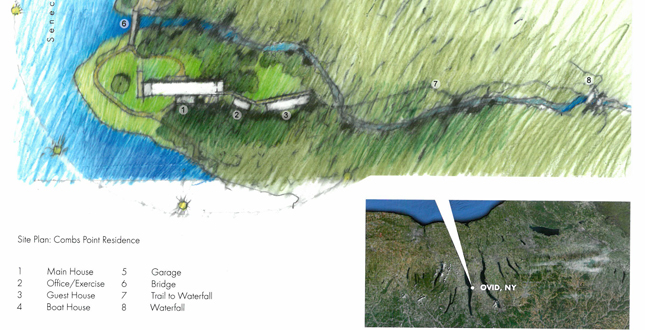 Close Me!
Close Me!Site Plan
Download Hi-Res ImageImage 1 of 16
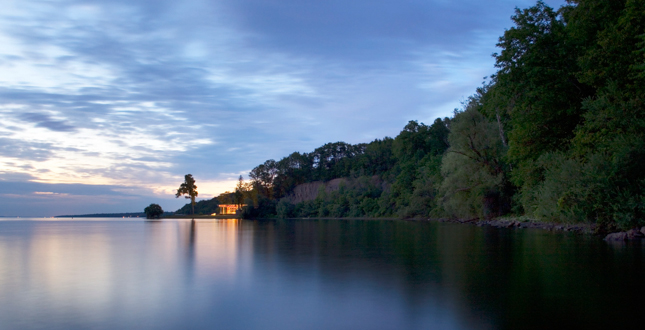 Close Me!
Close Me!Perched on the point, the living room becomes a light house on Seneca Lake at night.
Download Hi-Res ImageImage: Nic Lehoux
Image 2 of 16
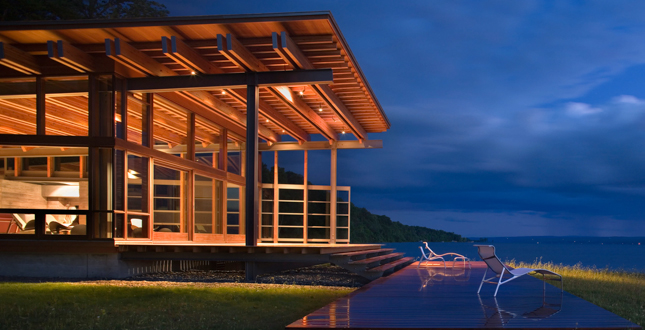 Close Me!
Close Me!The glass walls of the living room frame water views on three sides and slide open to extend the space outdoors. Even in the colder months, this family space feels like a large porch reaching toward the light.
Download Hi-Res ImageImage: Nic Lehoux
Image 3 of 16
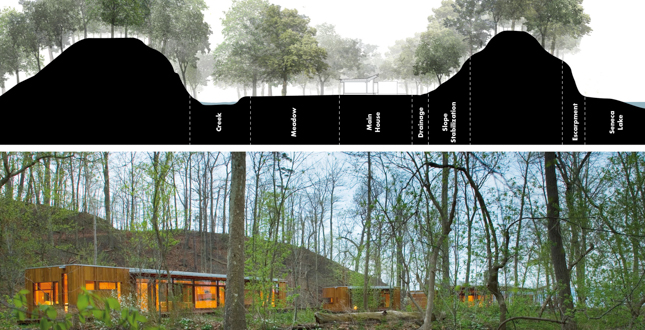 Close Me!
Close Me!The residence is surrounded by a formidable and unforgiving environment that is subject to high winds, cold temperatures, rocky terrain and harsh sun. The site is defined by the ravine's earthen walls and the creek, which cuts through it.
Download Hi-Res ImageImage: Nic Lehoux (photo), Michael Vergason Landscape Architects. Ltd. (section)
Image 4 of 16
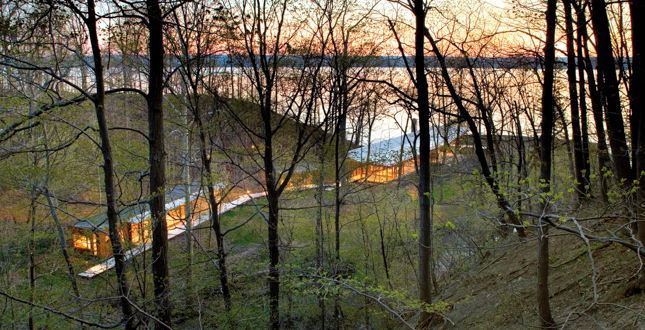 Close Me!
Close Me!As it slips through existing trees and vegetation toward the lake, the narrow footprint of the house touches lightly on the land and mimics the path of the nearby stream.
Download Hi-Res ImageImage: Nic Lehoux
Image 5 of 16
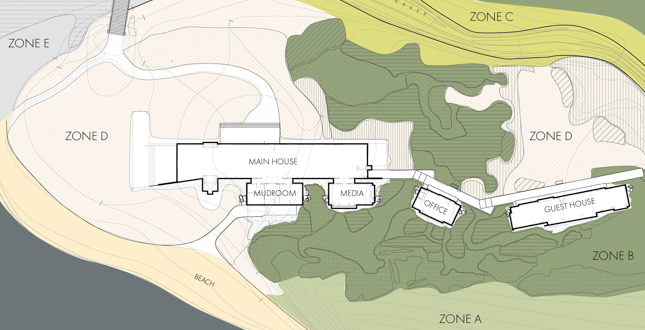 Close Me!
Close Me!Great care was taken to identify existing ecological communities on site and to curate planting groups within them. Within the five distinct zones, plant groupings reflect variations in elevation, slope and aspect. The mosaic of color and texture extends across the property from the forest to the house.
Download Hi-Res ImageImage: Michael Vergason Landscape Architects. Ltd.
Image 6 of 16
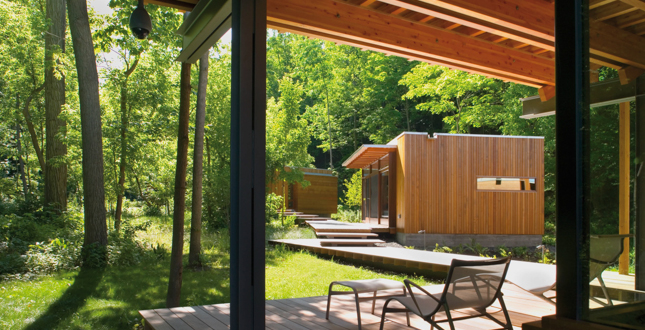 Close Me!
Close Me!The Sycamore-Cottonwood and Sugar Maple-Basswood-Ash woodland communities meet at the office to form a verdant corridor separating the meadows of the guest house and main house. New plantings augment and repair the connection.
Download Hi-Res ImageImage: Nic Lehoux
Image 7 of 16
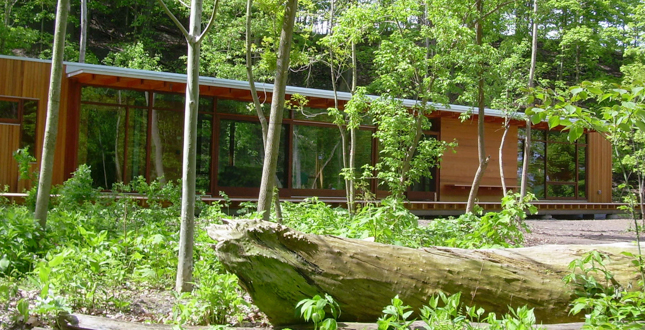 Close Me!
Close Me!As seen prior to the guest house meadow installation, the streamside plants, trees and the steep ravine provide a feeling of enclosure and connection to the existing woodland communities surrounding the house.
Download Hi-Res ImageImage: Michael Vergason Landscape Architects. Ltd.
Image 8 of 16
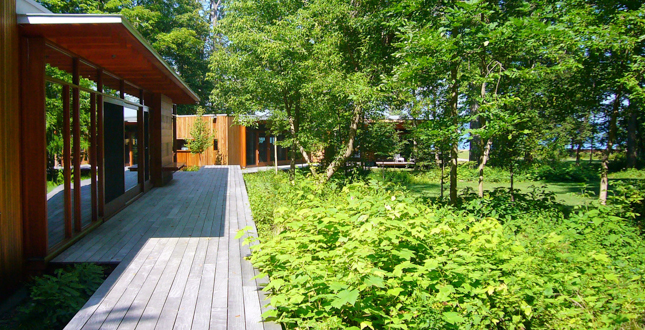 Close Me!
Close Me!Purple-flowering raspberry and existing canopy trees frame the custom mix of native fescues at the guest house meadow, creating an outdoor room.
Download Hi-Res ImageImage: Bohlin Cywinski Jackson
Image 9 of 16
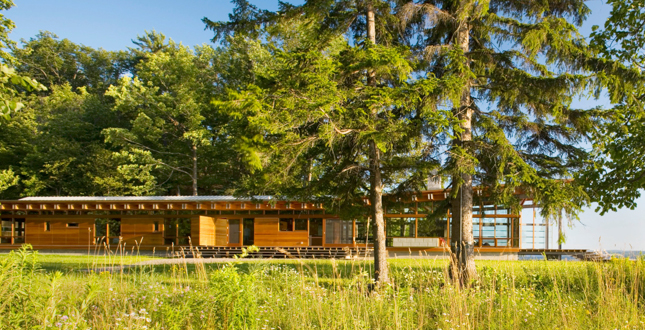 Close Me!
Close Me!After winding its way through the farmland of Upstate New York, Sixteen Falls Creek empties into Seneca Lake. The riparian grasses, rushes and forbs are adapted to withstand the seasonally-fluctuating water levels and stabilize the banks.
Download Hi-Res ImageImage: Nic Lehoux
Image 10 of 16
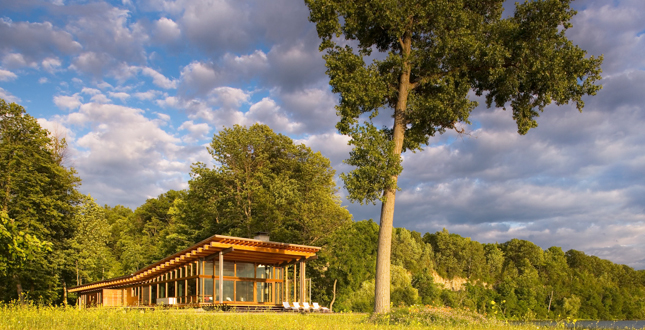 Close Me!
Close Me!An old cottonwood tree leans windward at the tip of Combs Point. Few trees were removed to accommodate the building footprint, except for those that were structurally flawed.
Download Hi-Res ImageImage: Nic Lehoux
Image 11 of 16
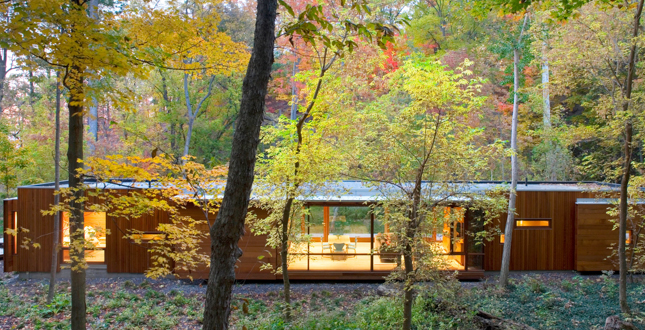 Close Me!
Close Me!The vibrant autumn color of the Sugar Maple-Basswood-Ash forest canopy envelops the house.
Download Hi-Res ImageImage: Nic Lehoux
Image 12 of 16
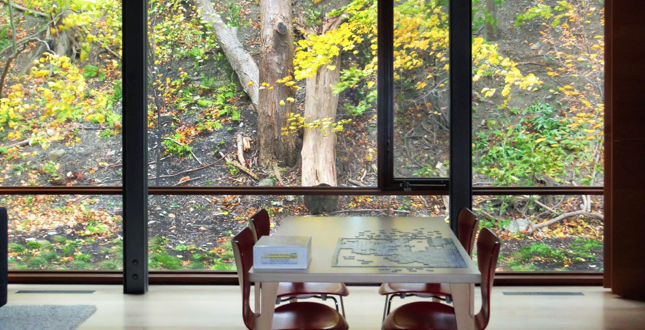 Close Me!
Close Me!Looking south from the guest house, the changing nature of the site’s steep ravine is brought inside with full window walls. Fallen trees stabilize the soil and the slope’s base functions as a drainage swale.
Download Hi-Res ImageImage: Nic Lehoux
Image 13 of 16
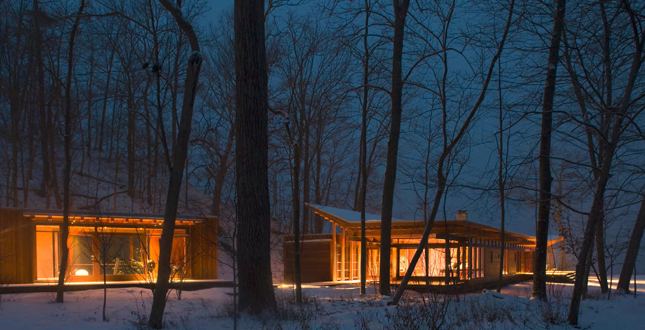 Close Me!
Close Me!The LA worked closely with the architect to site the building with minimal disruption of existing soil and vegetation to optimize sun exposed and protection from the elements. The result is a home that exhibits a distinct mood in each season.
Download Hi-Res ImageImage: Nic Lehoux
Image 14 of 16
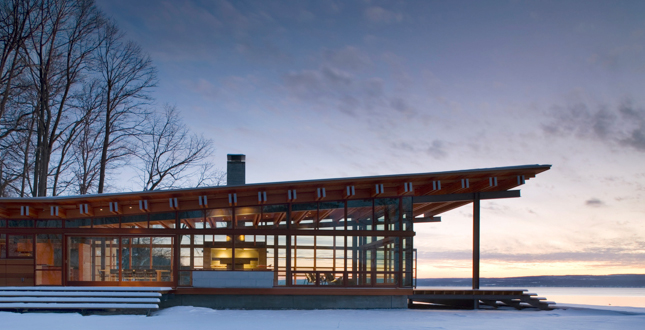 Close Me!
Close Me!Visitors approach the house on foot and see the silhouette of the northern elevation from the bridge over the creek. Vehicles remain at the garage up the hill.
Download Hi-Res ImageImage: Nic Lehoux
Image 15 of 16
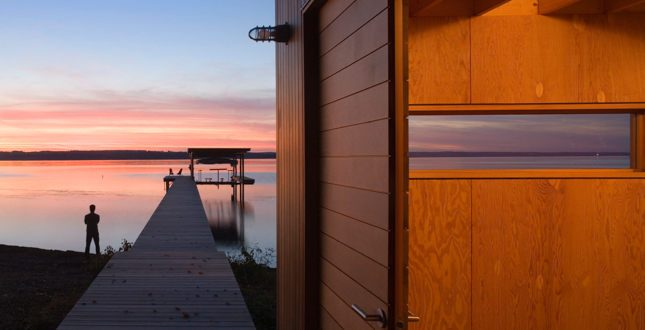 Close Me!
Close Me!Nestled at the base of a forested cliff, the utilitarian boathouse is transcendent at sunset.
Download Hi-Res ImageImage: Nic Lehoux
Image 16 of 16
Project Statement
Lightly touching down in a narrow glacial ravine is a family residence that responds boldly to its site on Seneca Lake in New York's northern Finger Lakes. A perennial stream laces through a rich forested glen, from a waterfall at its head to the fanning delta at the lake's edge. The robust woodland runs down the slopes and slips through the chain of wracked buildings, hugging the house, and tying it to the land in practical and ethereal ways.
Project Narrative
—2013 Professional Awards Jury
Existing Site
This property had a wildness that captured the client's interest immediately. They understood the raw beauty of Seneca Lake when they began looking for a site on the exposed eastern shoreline. A hunting lodge once sat on the site, but burned to the ground many years ago. It wasn't until they hiked upstream, into the 100-plus acre property's deep cut ravine that they found a waterfall, hidden within the site's botanically diverse plant palette. It was the site's inherent drama and ephemeral delicacy that bound the owners to this place and ultimately defined the design direction for the house and landscape.
Project Program
The project scope included a four-season weekend retreat for a family of four that supported their active life on the lake and love of the out-of-doors. In addition to three bedrooms for the main house, the architect was asked to create areas for office, exercise, and guests, in addition to a boathouse and garage. From the beginning, the Landscape Architect (LA) worked closely with the design team towards a strategy that would repair and enhance the site's ecological function.
Site Planning
The design decision to break the program down into separate but connected structures came from the need to respond to the narrow site, the solar orientation, and the disturbed area of the old hunting lodge. The extrusion of the parts along a line of circulation, the site's outdoor hallway, created opportunities for outdoor rooms formed by the interplay of existing trees and the framing of the space by the building walls.
The design resolution locates the primary family room on the point, like a boat, with its prow forward, exposed, and open to the drama of the seasons and the prevailing eastern winds at the water's edge. The more private rooms of the house gather behind this front room, and are more protected, nestled in the ravine. A bridge for pedestrians and the family's all-terrain vehicle spans the creek and connects the main house to the boathouse, which sits at the water's edge. Further still is a three-car garage on the bluff above the main building site. All cars remain high on the bluff at the garage, thereby limiting the primary circulation around the house to foot-traffic.
Landscape Strategy
The LA, the architect, and the client agreed that the site's inherent natural beauty and ecological diversity needed to be prioritized over all other site decisions. The client stressed the desire to be responsible ecological stewards so grading was minimized to pathways and roads and the diverse plant palette carefully edited to allow the house to slip into the existing landscape.
Planting
The charge of making the site appear untouched was far more difficult to achieve than it might seem. The LA began with a comprehensive survey of the existing plants and determined that the diversity of the herbaceous groundcover was both remarkable and unusual, even in the Finger Lakes. The LA, with a staff trained in landscape architecture, arboriculture and horticulture, determined that the project sat within four existing ecological communities: Dry Upland Forest, Moist Upland Forest, Floodplain Forest, and Seasonally Inundated Wetland. The project planting plan mixed these communities into five planting zones (See Planting Zones Diagram). The plant list is composed of plants that fall within a mix of vegetation communities (See Plant List).
Plant groupings within each zone reflect variations in elevation, slope and aspect. The most interesting lesson learned was that the shale soils change pH radically as they degrade. The tops of the relatively shallow ravine have much lower pH than the bottom. The result is extreme diversity in a small area because of the dramatic changes in soil pH, light, and weather (Seneca Lake's deep waters moderate the temperatures on the site, so it can be snowing at the garage when there is no snow at the main house).
There was not an analog upon which to model this project. Finding the appropriate plant material in nurseries proved challenging and it was difficult to find trees that blended seamlessly into the forest. The layout of the plants mimicked existing conditions so that the plants looked to be the result natural propagation in the microenvironments where they occur naturally. The careful culling or retention of existing material was an integral part of the project. Three years later, the site is healthier than ever, with bursts of trout lilies, trillium and ferns in the early spring.
Site Forces
This is a highly volatile site and the weather extremes are felt throughout the seasons. The builder and the LA discussed in detail site drainage and water flow to save existing trees. The LA planted the slopes and pinned down dead trees to provide slope and wind erosion control during seasonal storms and to trap organic material so seedlings could grow rather than wash out. Vegetation grows easily in the fertile soils of the flatland with its high water table at 18” deep. The stream run can be violent in the spring and after heavy rains, with water elevation changing from flood stage to nearly dry throughout the year. Rather than guarding against these conditions, the design team saw these ephemeral shifts as an essential part of the experience of the place.
Maintenance
During the two year planting process, it became apparent that a traditional approach to landscape management would not work. The LA wrote a meadow management plan for the different meadow areas but the plantings would require constant editing by someone who understood the plants over time and could choose which volunteers to keep and which to pull. The LA and client searched for the right person and found a botanist from Cornell University, who became so attached to the property that he now serves as a consultant that supervises the on-going site work. His discovery of a threatened New York State species on-site, Agastache nepetoides- Yellow Giant Hyssop, deepened his commitment to the place.
Materials and Site Details
All aspects of this project were carefully adapted to the site and considered for their regenerative results. The house design has a respectful relationship to the land and site, using sustainably harvested tropical wood for the boardwalk, a beach shale gravel path excavated from the shore edge of the site, New York granite paths, and beach shale splash blocks and drip lines.
Through careful siting and thoughtful interplay of architectural elements, this project shows the result of a highly collaborative design process where the role of each discipline is blurred to create a simultaneously bold and ethereal composition, unique to its place and time.
Project Resources
Design & Construction Team
Landscape Architect
Michael Vergason Landscape Architects, Ltd.
Michael Vergason, FASLA, FAAR
Melissa Gildea, ASLA, Certified Arborist, RLA
Brooke Cash, ASLA, RLA
Architect
Bohlin Cywinski Jackson
Design Principal
Peter Bohlin, FAIA
Project Manager
Todd Howard
Landscape Contractor
Ted Collins Tree and Landscape
Project Manager
Dan Hackett RLA, ASLA
General Contractor
Project Manager
Bill Duell
Featured Products
Seeds
Plants
Ted Collins Tree and Landscape
Soils
Manufactured on site from Rochester Municipal Waste Mulch, Canadian Peat Moss and site soils
Lighting
Paths and Roads
Shale
Harvested from beach




